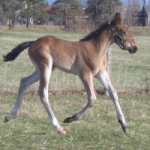 Horse owners showed they were willing to bet on Ontario’s horse racing industry, as prices for yearlings climbed slightly at an annual sale in London.
Horse owners showed they were willing to bet on Ontario’s horse racing industry, as prices for yearlings climbed slightly at an annual sale in London.
But breeders say they’re still losing money and need a solid plan with the Ontario Lottery and Gaming Corp. that will instil confidence in the industry.
“Before there’s going to be any confidence, people need to see the plan and see how it’s going to be,” said Ann Straatman of Seelster Farms in Lucan, the largest breeder in Ontario.
“People need to get into it, they need to see what racing opportunities will be and what the purse structure for races will be. Those things still have not been determined in the long term.”
The Forest City Yearling sale, held Saturday and Sunday at the Western Fair Agriplex, is one of two yearling sales in Ontario for standardbred horses — the other is in Flamboro in September.
Traditionally held in October, the London sale was pushed back to November to give the industry a peek at a final plan for horse racing that was released last month.
Seelster sold a yearling for $26,000 Sunday, but the average price of yearlings — horses that are about 18 months old — landed much lower, at $13,524.
Breeders need to get between $18,000 and $20,000 per yearling to make money, she said.
“Anything less than that and breeders aren’t making any money, they’re just sustaining their business and some less than that.”
The horse racing industry has tried to steady the ground beneath its feet since then-finance minister Dwight Duncan announced in March 2012 that the province was ending the slots-at-racetracks revenue-sharing program.
At the time of the announcement, the yearlings sold in this past weekend’s London sale were just being born.
The news immediately dropped the bottom out of an industry that at its peak had seen $345 million in revenue-sharing annually.
Since then the province has gone from breeding about 4,000 horses a year to breeding 1,200 as breeders faced uncertainty in the industry in the midst of a five-year breeding cycle.
“There’s no plugging that hole,” Bill O’Donnell, president of the Central Ontario Standardbred Association, said of the damage caused to Ontario breeders.
Though sales were up 23% at this year’s sale compared with 2012, breeders still aren’t making money, said Tammy McNiven of Twinbrook Farms in Embro.
“That’s very, very discouraging because people are losing their investments left and right and the government doesn’t seem to want to acknowledge that,” said McNiven, who’s also vice-president of the Standardbred Breeders of Ontario Association.
“I think people are still very leery. They still don’t know what the future holds even though we’ve been told there’s a five-year plan, we still don’t know how the five-year plan looks.”
McNiven and breeders like her are waiting for details about Ontario’s new racing model, expected to be in place by April.
Breeders need to work with Ontario Live Racing to build a solid racing product that people will bet on, she said.
“It’s not cheap to train a horse, we need return on the investment going forward.”
— — —
FOREST CITY YEARLING SALE
2013:
225 yearlings sold for $3 million
$13,524 average price per yearling
Top yearling sold for $130,000
Source: Standardbred Canada
2012:
257 yearlings sold for $2.7 million
$10,519 average price per yearling
2011:
263 yearlings sold for $4.8 million (five months before the province announced the end of the slots-at-racetrack program)
$18,311 average price per yearling in 2011
(The London Free Press)

